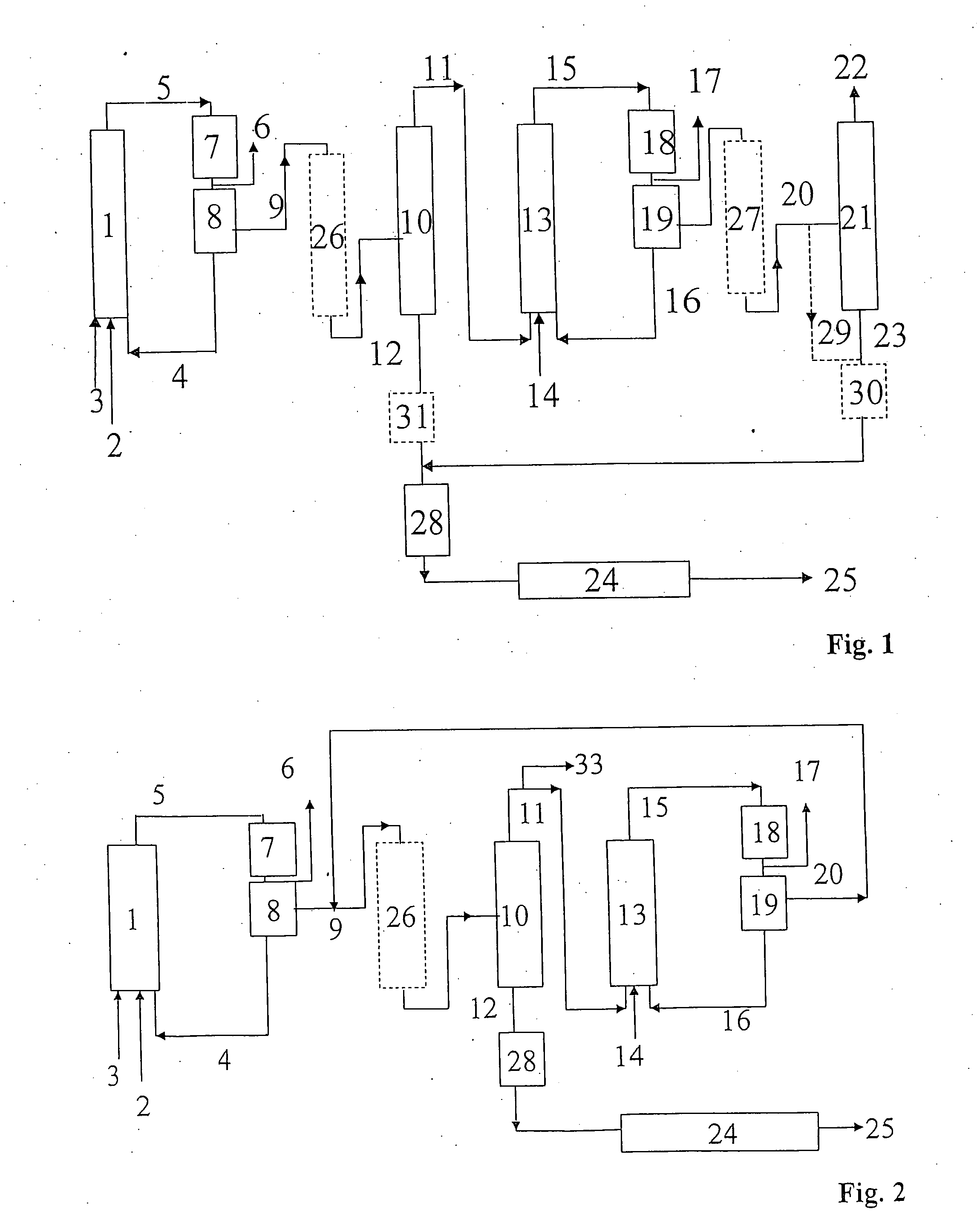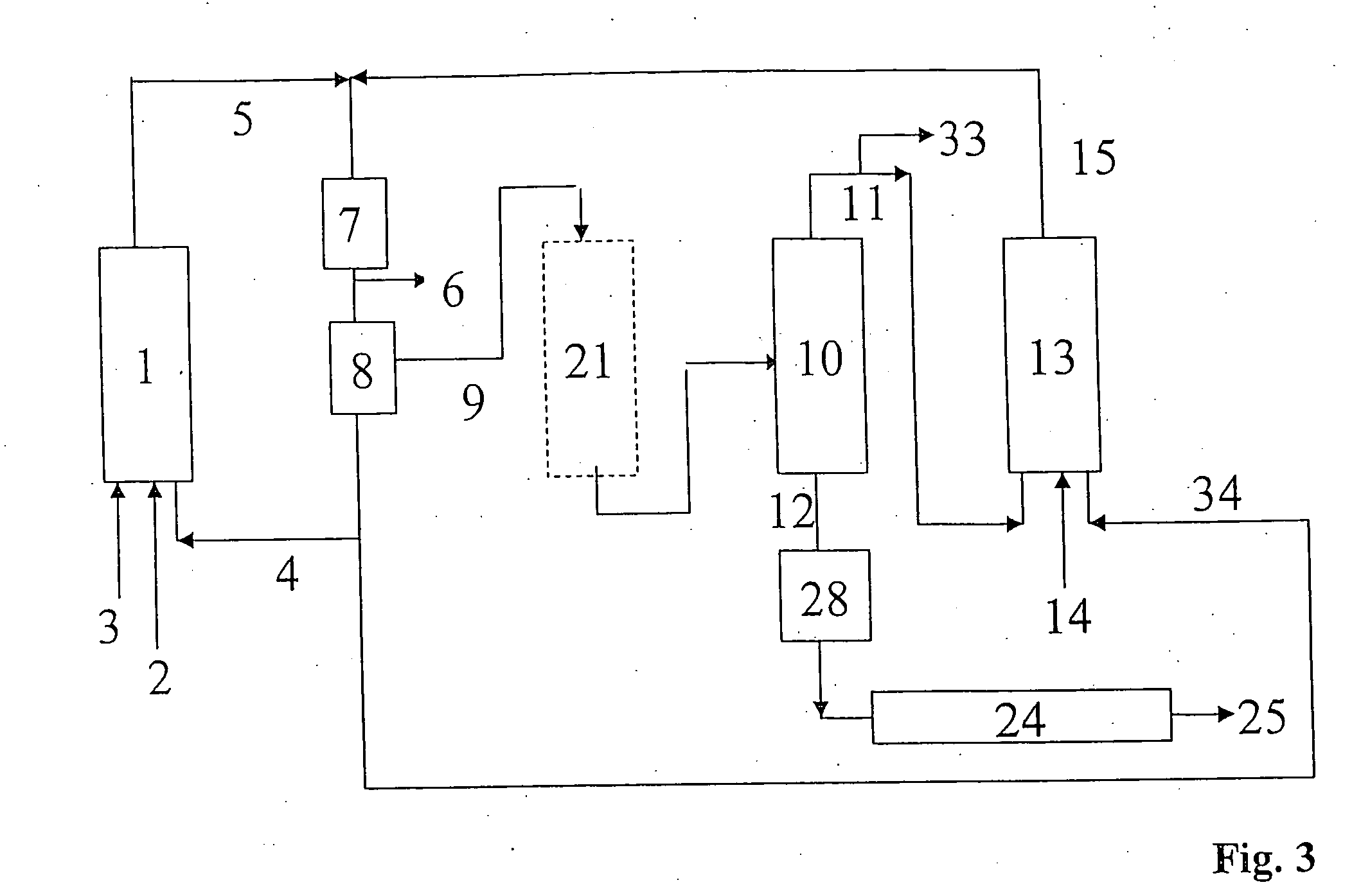Process for preparing alcohols from olefins by hydroformylation and hydrogenation
a technology which is applied in the field of hydroformylation and alcohol preparation of olefins, can solve the problems of adverse effects both on the hydrodynamics and the mass transfer and/or heat transport the conglutination of the first catalyst layer in the hydroformylation mixture, and the adverse effects of cobalt deposits on the hydrodynamics and the hydrodynamics of the hydrogenation reactor. achieve the effect of improving the process of production
- Summary
- Abstract
- Description
- Claims
- Application Information
AI Technical Summary
Benefits of technology
Problems solved by technology
Method used
Image
Examples
embodiment 1
[0108] In this embodiment, at least two reaction stages are employed, with the low-boiling fraction separated off in step f) being passed to step a) of the following reaction stage and the aldehyde-containing bottom fractions separated off in the steps f) of all reaction stages being hydrogenated in a joint step d). In this process variant, the steps a), b), c) and f) are carried out in succession and only the step d), viz. the hydrogenation of the aldehyde fraction, is carried out jointly for all reaction stages.
[0109] One variant of embodiment 1 of the process of the invention is shown in the form of a block diagram in FIG. 1. Step a) is carried out in a first hydroformylation reactor 1 into which an olefin mixture 3, synthesis gas 2 (carbon monoxide and hydrogen) and an aqueous solution of a cobalt compound or cobalt catalyst and water 4 are fed. The hydroformylation mixture 5 obtained in this way is depressurized into the step b) and the depressurized hydroformylation mixture i...
embodiment 2
[0112] In this embodiment of the process of the invention, two reaction stages are employed, with the low boilers separated off in step f) of the first reaction stage being passed to step a) of the second reaction stage and the organic output from step c) of both stages being passed to step f) of the first reaction stage. Here, each reaction stage comprises a hydroformylation step a), a cobalt removal step b) and a catalyst separation step c), with the catalyst phase which has been separated off being returned to the respective hydroformylation step. The organic phase which has been separated off is separated in a separation step f) common to both reaction stages into a low-boiling fraction and an aldehyde-containing subfraction. The low-boiling fraction obtained in this way is passed to the hydroformylation step a) of the second reaction stage, and the bottom fraction which has been separated off is passed to the adsorption step e) and subsequently the hydrogenation step d).
[0113]...
embodiment 3
[0117] In this embodiment of the process of the invention, two reaction stages are employed, with the low boilers separated off in step f) of the first reaction stage being passed to step a) of the second reaction stage and the steps b), c) and d) being carried out jointly for the two reaction stages.
[0118] One variant of this embodiment of the process of the invention is shown in the form of a block diagram in FIG. 3. An olefin mixture 3, synthesis gas 2 (carbon monoxide and hydrogen) and an aqueous solution of a cobalt compound or a mixture of cobalt catalyst and substream 4 are fed into the first hydroformylation reactor 1. The hydroformylation mixture 5 obtained in this way in step a) of the first reaction stage is depressurized together with the hydroformylation mixture 15 from the second hydroformylation reactor 13 (step a) of the second process stage) as combined hydroformylation outputs and, after the cobalt removal 7 (step b)), the organic phase is freed of the catalyst ac...
PUM
| Property | Measurement | Unit |
|---|---|---|
| temperature | aaaaa | aaaaa |
| pressure | aaaaa | aaaaa |
| pressure | aaaaa | aaaaa |
Abstract
Description
Claims
Application Information
 Login to View More
Login to View More - R&D
- Intellectual Property
- Life Sciences
- Materials
- Tech Scout
- Unparalleled Data Quality
- Higher Quality Content
- 60% Fewer Hallucinations
Browse by: Latest US Patents, China's latest patents, Technical Efficacy Thesaurus, Application Domain, Technology Topic, Popular Technical Reports.
© 2025 PatSnap. All rights reserved.Legal|Privacy policy|Modern Slavery Act Transparency Statement|Sitemap|About US| Contact US: help@patsnap.com


